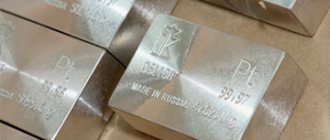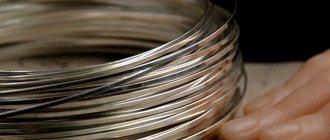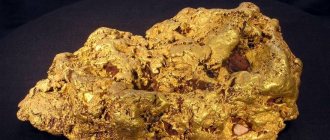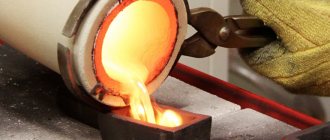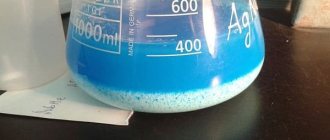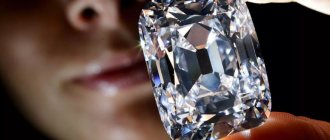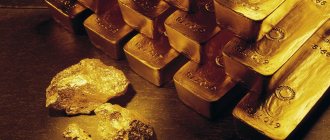Deep purification (refining) of precious metals from impurities contained in radio components is a profitable undertaking.
The profitability of the process is guaranteed if you have accurate information about which elements of electrical equipment contain gold, silver, platinum, and other precious metals, as well as how refining is carried out in practice.
In the article we will present a short list of radio components containing precious metals - more detailed information can be obtained from special reference books.
In addition, we will reveal methods for purifying such metals. In particular, we’ll talk about the “extraction” of noble elements from radio components using chemical methods and electrolysis.
The main “suppliers” of precious metals
Minimizing the use of rare earth metals in modern electrical engineering, associated with the goal of reducing the cost of the final product, makes refining radio components that have lost their practical use a futile exercise - the end result does not recoup the investment.
manufactured in the USSR are another matter . Especially the elements that were produced for various equipment related to the defense industry.
In such products, even from one device, you can “mine” tens of thousands of rubles worth of precious metals. To understand which radio components contain precious elements, we offer a table:
| Item name | Short description |
| Capacitors | These can be elements in a ceramic (CM) or plastic shell (case), as well as capacitive tantalum (tantalum-silver) capacitors assembled in the USSR. |
| Lamps for generators | Precious metals are contained in these products marked GMI, GI, GS and GU. |
| Microcircuits | A number of noble metals of interest can be extracted from elements in the 133, 564, 1533, 155, 142, 530, 134 series. |
| Transistors | In this part, just like in a relay, the content of noble metals is observed in products of domestic (Soviet, Russian) and foreign production. |
| Resistors | For refining, you need to purchase (find) elements with the following markings: SP5 (from 1 to 44), SP3 (from 19 to 44), PP3 (from 40 to 47). |
| Potentiometers | Elements labeled PPLM, PPMF, PTP and PLP are of interest for recycling (processing). |
| Connectors, switches, buttons | Yellow elements most likely contain gold. Products of other shades must be checked for precious metal content. |
Of course, this is not the entire list of radio components from which platinum, gold and silver, as well as other precious metals, can be extracted at home using reagents or electrolysis. More detailed information about the content of noble elements in various devices can be found here.
Currently, purchasing elements containing rare earth metals is a fairly labor-intensive undertaking .
The fact is that the vast majority of radio components produced in the era of developed socialism have already been recycled.
Therefore, it takes a lot of effort and ingenuity.
After all, for example, in order to “mine” 5.45 g of gold and 0.34 g of silver, you need to have a thousand microcircuits marked KR1108PP2.
Contents in radio components
Very often gold is used in radio electronics to coat tracks and contacts. A considerable percentage of this metal was contained, for example, in Soviet microcircuits - about 1/20 of the part. As is known, gold-containing capacitors are particularly rich in precious metals; You can also try your luck to detect gold in some transistors.
Gold in radio components
There are capacitors the size of a 3-liter jar, the gold content of which is 8 grams. However, it is now on the verge of being possible to obtain such capacitors - they were used only for military needs and classified as “secret”, and they are expensive.
This metal is also contained, although in small quantities, in radio tubes. Next to the cathode there is a grid on which it is applied. Gold plating is placed on such a grid to prevent it from overheating, which can lead to lamp failure. Gold plating can also be found on some lighting fixture legs. Naturally, we are talking only about old-style devices.
Now, to save money, parts that were previously gold-plated are replaced with cheap tungsten and contain gold in very small quantities. Previously, precious metals could be found all over the place. Which, by the way, is a problem for people who work in government agencies, since when decommissioning a failed device, it is necessary to hand over all radio components containing precious metals. In many Soviet devices, their number was indicated even in passports.
Also, the precious metal in radio components can be found in devices that were manufactured for military needs. It may also contain the following details:
- gold, silver and platinum may be contained in small quantities in some semiconductors, for example, zener diodes, diodes, optocouplers and others;
- Many connectors were coated with gold several microns thick;
- capacitors used for military equipment also contain it in large quantities;
- radio tubes and transistor substrates.
Which radio components contain the largest amount of gold:
- some diodes from the D226 series;
- microcircuits 133 and 155 series;
- contacts and relays;
- some transistors from the KT series, for example, 603, 630, 117, 3102, 844A, 911 and others.
Getting gold
The algorithm for purifying this precious metal using reagents – chemically – is as follows:
- In a special container, you need to mix 1 liter of sulfuric acid with a density of 1.8 g/cm2 and 250 ml of hydrochloric acid with a density of 1.19 g/cm2.
- We heat the resulting composition to a temperature of 60 - 70 degrees.
- We lower prepared elements into the heated solution - with a minimum amount of impurities. Thus, reagents will be used economically.
- After immersing the raw material, add nitric acid , obtaining a mixture called “aqua regia.” Proportion of the new solution: 3 parts hydrochloric acid and 1 part nitric acid.
Gold settles in small particles that cannot be detected with the naked eye. By adding hydrazine at the rate of 1 ml/100 ml of aqua regia solution, we start the process of precipitation of the yellow metal.
The precipitation procedure will take approximately 4 hours, during which the mixture must be stirred periodically.
At the end, we filter the solution through a dense filter, melt the sediment under a layer of borax in a crucible at a temperature of 1100. The resulting gold is separated from the borax.
Working with chemicals requires compliance with safety precautions . The presence of personal protective equipment - a respirator, rubberized gloves, an apron is required. Work is carried out in a well-ventilated area.
Using electrolysis, this rare earth element is separated from brass and copper alloys, where gold is deposited in a thin layer.
Anodic dissolution of a precious metal implies the presence of a special container into which hydrochloric or sulfuric acid must be poured.
The process is carried out at an acid temperature of 15 – 25 .
A lead or iron plate is used as a cathode. The current density should be 0.1 - 1 A/dm2. It is the current density indicator that indicates the dissolution of the precious metal during the electrolysis process. In particular, a drop in density indicates the dissolution of gold.
The final stage does not differ from the described operations in the process of chemical “extraction” of the yellow metal.
More detailed information about gold refining at home can be found at this link (Gold refining at home).
Silver extraction
In electronic equipment, this metal is used in its pure form (relay contacts) and as a thin coating on radio components (contacts, housing outside and inside).
Silver removed from elements made of brass and copper using a solution of sulfuric and nitric acid in a ratio of 19:1.2 at a mixture temperature of up to 80 degrees.
We extract the dissolved silver by adding the same amount of zinc shavings or dust to the mixture. The required amount of zinc can be taken from the battery casing.
Also, this precious metal is “mined” by acidifying the electrolyte with small doses of hydrochloric acid . The procedure is dangerous , so it is advisable to carry it out in a fume hood. During the operation, the precious metal is precipitated into silver chloride, which is similar in consistency to a white curd mass.
The resulting mass should be given
a day to settle .
After 24 hours, we check the filtered sediment for the density of precious metal content by adding hydrochloric acid. Then, silver chloride precipitate is filtered through dense fabric (calico), thoroughly washed and dried at a temperature of 105 - 120.
After which, already in dry form, this mass must be fused with a gas burner or cutter.
We talked in more detail about removing silver from various contacts here (How to remove silver from contacts).
Isolation of platinum
This rare earth element can be extracted from radio components by immersing them in platinum electrolyte, which is used as anodes.
In this case, the technical parameters of the electrolyte should look as follows : platinum in terms of metal 15 – 25 HCL (1.19 g/cm3) 100 – 300 pH no more than 2.2. Current density indicator is 3.6 A/dm2. The solution temperature should be 45 - 70 degrees.
This is quite difficult to do without special equipment. It is much easier to resort to refining platinum using nitric acid , into which it is necessary to immerse radio components containing this noble metal.
The precious metal will precipitate. Carefully pour the excess acid into another container, and extinguish the sediment with ordinary baking soda. We talked in more detail about refining palladium at home here.
What are the dangers and results?
To extract gold from radio components with your own hands, you need to wait 6 hours until chemical processes dissolve all the elements. At this time, nitrogen oxide is rapidly released; it is a toxic yellow smoke that poses a serious danger to humans. One breath of this gas can lead to loss of consciousness. Poor ventilation can result in death!
After dissolving the elements, you need to proceed to the following procedures. The gold precipitate will not be visible in the liquid; the metals in it will dissolve to the state of molecules.
To assemble the precious metal into a single whole, we will use hydrazine. It is found in powder and liquid form. To complete the procedure, you need 250-300 grams; it is added to a container with aqua regia. The result should be a brown precipitate. Outwardly it looks like rust, if absent, no gold was used in the parts.
The solution is filtered, and the flakes are purified in aqua regia until the gold acquires its proper appearance.
Note!
FIFA 22 (PS4)Why do you need interior dolls?
- How to choose shoes that don't go out of fashion?

